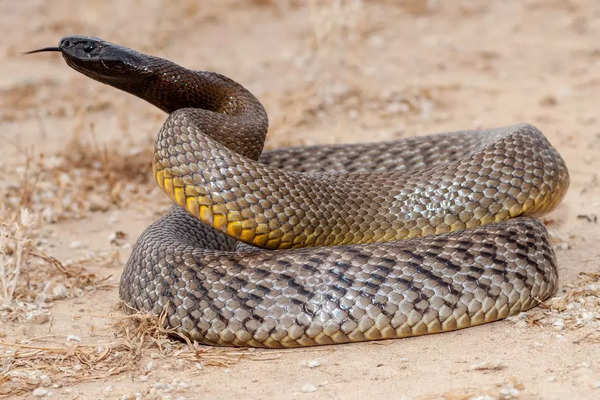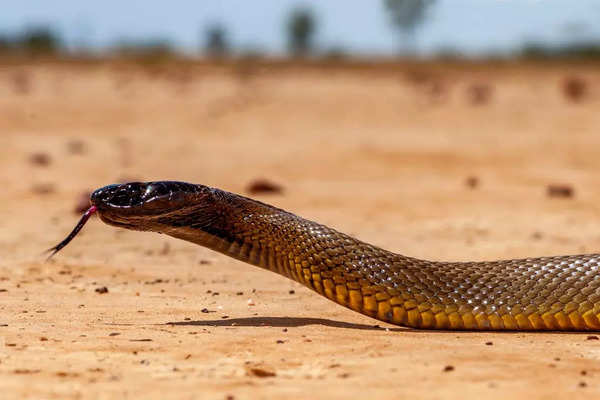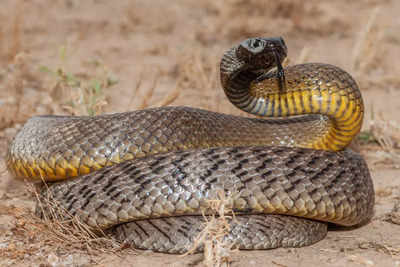The Inland Taipan is popularly known as the most venomous snake in the world, also known as the “fierce snake,” it is a demure yet lethal inhabitant of central Australia’s arid regions. This shy serpent often remains hidden from human eyes due to its solitary lifestyle and remote habitat, and also because its holds a venomous secret.
A single bite from the Inland Taipan can deliver a deadly cocktail of neurotoxins, coupled with many others that are capable of causing death within 45 minutes if left untreated. Apart from other venom possessing snakes, it primarily preys on mammals, that makes its venom particularly effective against warm-blooded creatures, including humans. Despite its lethal potential, the Inland Taipan is surprisingly shy and prefers to avoid confrontation, and bites only when it feels threatened. It is also a combination of paradoxes, which is extreme shyness and deadly power that makes it one of the most interesting creatures in the animal kingdom.

Here are some weird facts about the Inland Taipan:
How deadly is the venom?
The Inland Taipan’s venom is surprisingly powerful, as a single bite contains enough toxin to kill 100 adult humans. Its venom is 50 times more potent than that of the Indian cobra and 10 times more lethal than a rattlesnake’s. This exceptional efficiency of the venom is due to a complex mix of neurotoxins, hemotoxins, myotoxins, and nephrotoxins, which come together and cause rapid paralysis, internal bleeding, muscle damage, and kidney failure in the human being bitten by the serpent.
The Inland Taipan is a shy creature!
Although this deadly snake has a fearsome image among the people for its lethal potential , the Inland Taipan is one of the least encountered snakes and is deeply fond of remaining elusive in its habitat that spans the remote and arid regions of central Australia, where it spends most of its time hidden in deep soil cracks and crevices. Being regarded as an uncommon and mysterious creature is due to its reclusive habit, which significantly reduces chances of human interactions.

What does the Serpent eat?
Hunting tiny creatures like rats and mice is the main source of the Inland Taipan’s highly specific diet. Its venom is specially designed to make these prey species quickly paralyzed so they are unable to escape or pose a threat. Because of its preferred food, the Inland Taipan is also unlikely to attack people unless provoked.
The Inland Taipan is swift and precise
The Inland Taipan is well known for its amazing agility, which allows it to attack with pinpoint accuracy and lightning speed. It frequently delivers several bites quickly one after the other, injecting a significant amount of venom with each blow. The snake can swiftly disable its victim and reduce the chance of harm because of this effective hunting technique.
Surprisingly! The Inland Taipan is not aggressive
Contrary to its deadly potential, the Inland Taipan is surprisingly docile and not aggressive. It tends to avoid confrontation and usually escapes if given the opportunity. When threatened, it shows a defensive posture, flattening its body and hissing loudly to ward off potential threats. Bites to humans are exceedingly rare, as the snake only bites when it feels provoked.
Environmental adaptations
Inland Taipans are highly adapted to live in their harsh, arid surroundings. They can survive in extreme temperatures and go for extended periods without water. During the sweltering summer months, they tend to stay inactive, finding shelter in cooler burrows, whereas in the cooler seasons, they become more active and search for food.
What are the future implications of the Inland Taipan
The Inland Taipan, the world’s most venomous snake, faces future threats due to climate change, habitat loss, and competition with invasive species. Changes in the ecosystem and human activities, such as agriculture and urbanization, could impact its population and habitat. The introduction of non-native species may lead to increased competition for food. Ongoing conservation efforts and research are crucial to monitor the Inland Taipan’s population and health. Despite current “Least Concern” status, continued vigilance is necessary to ensure its survival and to understand the effects of environmental changes and human activities on this unique species.
Photo Credits: Canva




